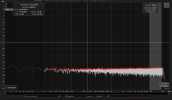Hey all and a Happy New Year!
I've been playing around with the E1DA Cosmos and I want o share some results. I think that the Cosmos is a great tool and together with REW and a good DAC, it makes a great amplifier/DAC/preamp measuring tool-chain.
I measured my D50s and my SMSL SU9-n DACs and the THD numbers match with what Amir measured but the THD+N numbers are way below what Amir had in his posts.
Below you can see the measurement for the D50s. The second harmonic is just below -120dB and this is similar to what Amir had. The THD measurement in the upper left box says -116.9 dB and this seems OK by looking at the graph itself but the THD+N measurement of -95.8 dB does not seem correct. BY looking at the graph, it should be somewhere around -110dB. The nise floor of the measurement is similar to what Amir showed in his review.

Next I measured the SU9-n (below) and the THD was at an incredible -129 dB, again, very similar to what Amir was showing, but again, the THD+N measurement is around -95 dB and by looking at the graph, there is indication it shouldn't be anywhere close to -120 dB.

Overall, both DACs measure incredibly well and the Cosmos is a really great ADC. Is there something I'm missing regarding the THD+N measurement? It looks like REW is not able to measure below -95 dB.
For measuring, I powered the D50s from a battery pack and the Cosmos from another battery pack. Measurements were performed using a laptop n battery power. For the SU9-n, I obvirously used it's internal power supply powered from 230Vac.
I've been playing around with the E1DA Cosmos and I want o share some results. I think that the Cosmos is a great tool and together with REW and a good DAC, it makes a great amplifier/DAC/preamp measuring tool-chain.
I measured my D50s and my SMSL SU9-n DACs and the THD numbers match with what Amir measured but the THD+N numbers are way below what Amir had in his posts.
Below you can see the measurement for the D50s. The second harmonic is just below -120dB and this is similar to what Amir had. The THD measurement in the upper left box says -116.9 dB and this seems OK by looking at the graph itself but the THD+N measurement of -95.8 dB does not seem correct. BY looking at the graph, it should be somewhere around -110dB. The nise floor of the measurement is similar to what Amir showed in his review.
Next I measured the SU9-n (below) and the THD was at an incredible -129 dB, again, very similar to what Amir was showing, but again, the THD+N measurement is around -95 dB and by looking at the graph, there is indication it shouldn't be anywhere close to -120 dB.
Overall, both DACs measure incredibly well and the Cosmos is a really great ADC. Is there something I'm missing regarding the THD+N measurement? It looks like REW is not able to measure below -95 dB.
For measuring, I powered the D50s from a battery pack and the Cosmos from another battery pack. Measurements were performed using a laptop n battery power. For the SU9-n, I obvirously used it's internal power supply powered from 230Vac.

